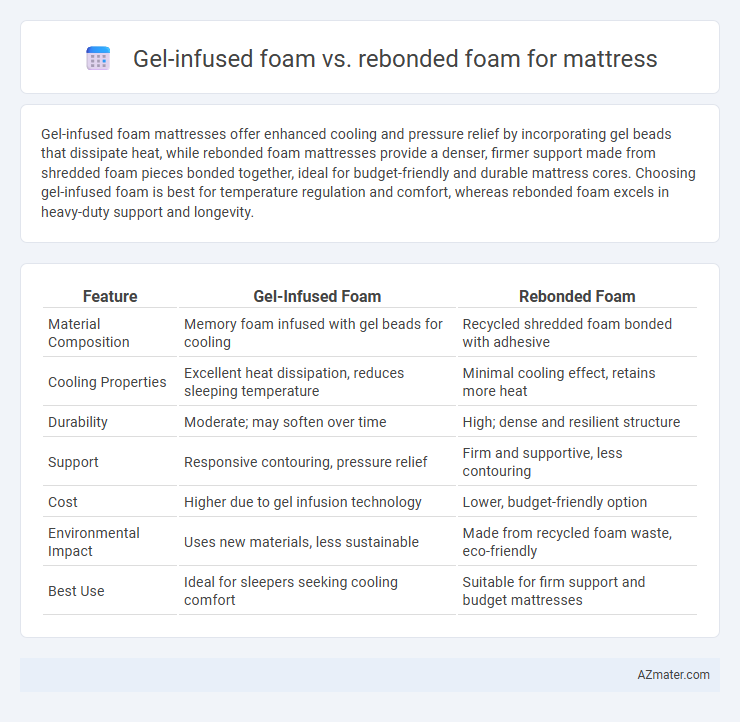Gel-infused foam mattresses offer enhanced cooling and pressure relief by incorporating gel beads that dissipate heat, while rebonded foam mattresses provide a denser, firmer support made from shredded foam pieces bonded together, ideal for budget-friendly and durable mattress cores. Choosing gel-infused foam is best for temperature regulation and comfort, whereas rebonded foam excels in heavy-duty support and longevity.
Table of Comparison
| Feature | Gel-Infused Foam | Rebonded Foam |
|---|---|---|
| Material Composition | Memory foam infused with gel beads for cooling | Recycled shredded foam bonded with adhesive |
| Cooling Properties | Excellent heat dissipation, reduces sleeping temperature | Minimal cooling effect, retains more heat |
| Durability | Moderate; may soften over time | High; dense and resilient structure |
| Support | Responsive contouring, pressure relief | Firm and supportive, less contouring |
| Cost | Higher due to gel infusion technology | Lower, budget-friendly option |
| Environmental Impact | Uses new materials, less sustainable | Made from recycled foam waste, eco-friendly |
| Best Use | Ideal for sleepers seeking cooling comfort | Suitable for firm support and budget mattresses |
Introduction to Gel-Infused Foam and Rebonded Foam
Gel-infused foam is designed with cooling gel particles embedded within traditional memory foam to enhance temperature regulation and provide pressure relief. Rebonded foam, made by compressing shredded foam scrap into a dense, firm material, offers durable support and cost-efficiency, often used as a mattress base layer. Understanding the distinct properties of gel-infused and rebonded foams helps consumers select mattresses that balance comfort, support, and thermal management.
Composition and Structure of Gel-Infused Foam
Gel-infused foam is composed of polyurethane foam infused with gel beads or gel swirls that enhance temperature regulation by absorbing and dissipating heat, providing a cooler sleep surface. Its open-cell structure promotes airflow and improves breathability, reducing heat retention common in traditional memory foams. In contrast, rebonded foam is made from shredded foam scraps bonded together under pressure, resulting in a denser and firmer material primarily designed for support rather than temperature control.
What is Rebonded Foam?
Rebonded foam is a dense, high-resilience material made from shredded polyurethane foam scraps that are bonded together using a polyurethane binder under heat and pressure, resulting in a firm and durable mattress core suitable for heavy use. Unlike gel-infused foam, which offers temperature regulation and pressure relief through gel beads or layers, rebonded foam emphasizes strong support and longevity with less contouring or cooling properties. This type of foam is often utilized in foundation layers or budget-friendly mattresses where firmness and robustness are prioritized over softness and breathability.
Comfort and Support: Gel-Infused Foam vs Rebonded Foam
Gel-infused foam offers enhanced comfort through its superior temperature regulation and pressure relief, making it ideal for side sleepers and those prone to overheating. Rebonded foam provides firm, durable support with high density, suitable for heavier individuals and those needing consistent spinal alignment. Comparing support and comfort, gel-infused foam excels in cushioning and breathability, while rebonded foam prioritizes structural integrity and longevity.
Breathability and Temperature Regulation
Gel-infused foam mattresses excel in breathability and temperature regulation due to the gel beads that absorb and dissipate heat, maintaining a cooler sleep surface. Rebonded foam, composed of shredded foam pieces glued together, tends to retain more heat and offers less airflow, often leading to a warmer sleep experience. Choosing gel-infused foam enhances airflow and reduces heat buildup, making it ideal for hot sleepers seeking optimal comfort and temperature control.
Durability and Lifespan Comparison
Gel-infused foam offers enhanced durability due to its ability to maintain structural integrity and resist sagging, typically lasting 7 to 10 years with consistent support. Rebonded foam, made from recycled foam scraps bonded together, tends to be denser but less resilient, often showing wear and reduced comfort within 5 to 7 years. The lifespan of gel-infused foam mattresses generally outperforms rebonded foam by providing longer-lasting comfort and resistance to heat buildup and material degradation.
Pressure Relief and Spinal Alignment
Gel-infused foam offers superior pressure relief by evenly distributing body weight and dissipating heat, promoting cooler sleep and reducing pressure points on hips and shoulders. Rebonded foam, made from recycled foam scraps bonded together, provides firmer support that helps maintain spinal alignment but may lack the contouring and breathability features critical for targeted pressure relief. Choosing gel-infused foam enhances comfort for side sleepers and those with joint pain, while rebonded foam suits individuals needing firm, durable support for optimal spinal posture.
Motion Isolation: Which Foam is Better?
Gel-infused foam excels in motion isolation due to its ability to absorb and dissipate movement, minimizing disturbances between sleepers. Rebonded foam, while denser and durable, tends to transfer more motion compared to gel-infused foam, making it less effective at isolating motion. For minimizing partner disturbance and achieving superior motion isolation in mattresses, gel-infused foam is generally the better choice.
Eco-Friendliness and Material Safety
Gel-infused foam mattresses incorporate non-toxic, hypoallergenic materials and are often CertiPUR-US certified, ensuring low emissions of harmful chemicals, thus promoting eco-friendliness and material safety. Rebonded foam, made from recycled foam scraps bonded with adhesives, supports sustainability by repurposing waste but may contain chemical binders that raise concerns about off-gassing and indoor air quality. Choosing gel-infused foam offers a balance between comfort and certified material safety, while rebonded foam emphasizes environmental recycling but requires scrutiny of adhesive components for health impacts.
Price Comparison and Value for Money
Gel-infused foam mattresses typically cost more than rebonded foam options due to advanced cooling properties and enhanced comfort support. Rebonded foam offers a budget-friendly alternative with firm support but may lack the temperature regulation and durability of gel-infused foam. For value-conscious buyers, rebonded foam provides affordability, while gel-infused foam delivers superior comfort and longevity, often justifying the higher investment.

Infographic: Gel-infused foam vs Rebonded foam for Mattress
 azmater.com
azmater.com